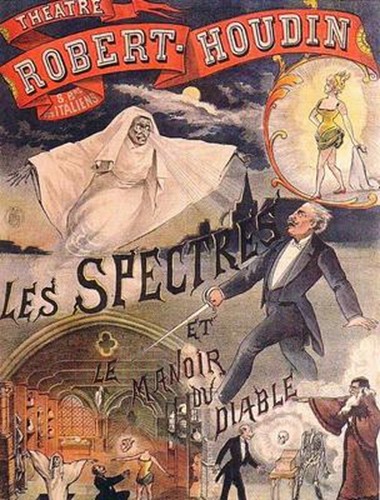Horror films are a movie genre seeking to ignite a negative emotional reaction from viewers by playing on the audience's most primal fears. They often feature scenes that startle the viewer through the means of macabre and the supernatural, therefore they may overlap with the fantasy and supernatural genre. Horror movies frequently overlap with the thriller genre.
The first depictions of supernatural events appear in several of the silent shorts created by the film pioneer Georges Méliès in the late 1890s, the best known one being "Le Manoir du diable", which is more commonly known as "The Haunted Castle", which was released in 1896 and is sometimes credited as being the first horror film. The movie only lasted two minutes, but audiences loved it, and Mèliès took pleasure in giving them even more devils and skeletons.
In the early 1900's German filmmakers created the first horror-themed feature films and director Paul Wegener enjoyed great success with his version of the old Jewish folk tale "Der Golem" in 1913. This story about an enormous clay figure, which is brought to life by an antiquarian and then fights against its forced slavery and it was a clear precursor to the many monster movies that flourished in Hollywood during the 1930's.
In the nuclear-charged atmosphere of the 1950s the tone of horror films shifted away from the gothic and towards the modern day society. A large amount of low-budget productions featured humanity overcoming threats from life and objects outside our world such as, alien invasions, deadly mutations to people, plants, and insects. The better horror films of this period, including "Howard Hawks" and "The Thing From Another World" (1951) managed to channel the paranoia of the Cold War into atmospheric creepiness without resorting to exploitation. Filmmakers would continue to merge elements of science fiction and horror, most notably in the movie "Ridley Scott's Alien" (1979).
The late 1950s and early 1960s saw the rise of studios centered specifically around horror, notably British production company Hammer Films, which specialized in bloody remakes of classic horror stories, which made a series of Edgar Allan Poe themed films starring Vincent Price. These sometimes controversial productions carved the way for more explicit violence in both horror and mainstream films.
Later in the 1960s the genre moved towards non-supernatural psychological horror, with thrillers such as Alfred Hitchcock's Psycho (1960) using all-too-human monsters rather than supernatural ones to scare the audience. Michael Powell's Peeping Tom was a notable example of this genre. Psychological horror films would continue to appear sporadically with 1991's The Silence of the Lambs a later highlight of the subgenre.
In the late 1960s and 1970s a public fascination with the occult fed and was fed by a series of serious, supernatural-themed, often explicitly gory horror movies. Roman Polanski's "Rosemary's Baby" in 1968 was a critical and popular success and laid the groundwork for the seminal horror film "The Exorcist" in 1973. Far from exploitation, these films incorporated subtext and symbolism and had production values equal to any serious film of the time. The Exorcist spawned numerous sequels and imitators but most notably was "The Omen" (1976).
The genre fractured somewhat in the late 1970s, with mainstream Hollywood focusing on disaster movies such as "The Towering Infern"o and blockbuster thrillers such as "Jaws" while independent filmmakers upped the ante with disturbing and explicit gore-fests such as, "The Texas Chainsaw Massacre" in 1974. An effective and atmospheric shocker, Halloween introduced the teens threatened by superhuman evil theme that would be copied in dozens of lesser, increasingly violent movies throughout the 1980s including the well-known "Friday the 13th" and "A Nightmare on Elm Street" series, as well as other Halloween related horror movies.
Le Manoir du diable:

Due to the evolution in technology and graphics, film makes in modern day are able to create more realistic and gruesome movies. An example of this could be shown in the two posters shown and how in themselves depict the evolution of the horror genre.
Saw 1:

No comments:
Post a Comment